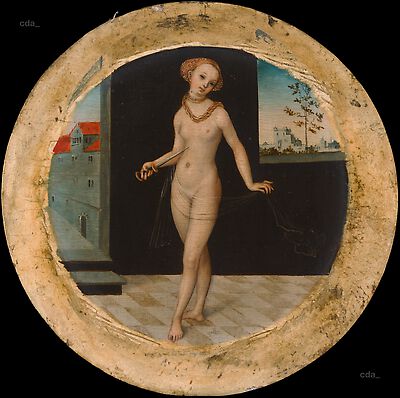- Attribution
- Lucas Cranach the Elder
Attribution
| Lucas Cranach the Elder | [Sotheby's online database; http://www.sothebys.com/en/auctions/ecatalogue/2013/old-master-british-paintings-evening-l13036/lot.3.html?locale=en; accessed 20-03-2019] |
- Production dates
- about 1525 - 1527
about 1526 - 1537
Production dates
| about 1525 - 1527 | [Sotheby's online database; http://www.sothebys.com/en/auctions/ecatalogue/2013/old-master-british-paintings-evening-l13036/lot.3.html?locale=en; accessed 20-03-2019] |
| about 1526 - 1537 | [Friedländer, Rosenberg 1979, 118, Nr. 240E] |
- Dimensions
- Dimensions of support: 14.9 cm (diameter)
Dimensions
Dimensions of support: 14.9 cm (diameter)
[Sotheby's online database; http://www.sothebys.com/en/auctions/ecatalogue/2013/old-master-british-paintings-evening-l13036/lot.3.html?locale=en; accessed 20-03-2019]
- Signature / Dating
Artist's insignia at bottom centre: winged serpent with elevated wings, facing right; in black paint
Signature / Dating
Artist's insignia at bottom centre: winged serpent with elevated wings, facing right; in black paint
[cda 2019]
- Owner
- Private Collection
- Repository
- Private Collection
- CDA ID
- PRIVATE_NONE-P253
- FR (1978) Nr.
- FR240E
- Persistent Link
- https://lucascranach.org/en/PRIVATE_NONE-P253/
